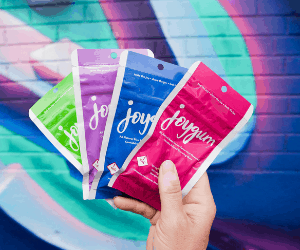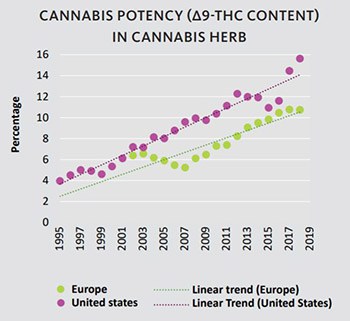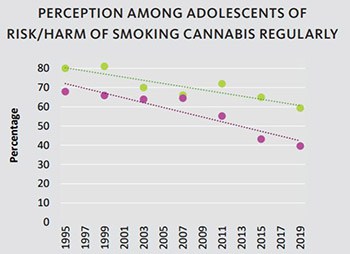Three years after their product launch and over 15 years since the idea came about, Amy and Dave Nudelman have secured a patent for their tetrahydrocannabinol (THC) and cannabidiol (CBD) infused chewing gum, Joygum.
Amy is the owner of Joygum, and her husband, Dave, works as a consultant for her.
The product is currently sold in about 225 stores in Colorado and is available in two of the largest dispensary chains in the state: The Green Solution and LivWell, Amy says.

© Courtesy of Joygum
Joygum comes in seven flavors, with three sugar-free options and varying CBD and THC ratios.
Each flavor comes in a 10-piece package or ten servings. Lemon Mint, Watermelon Spearmint, Bubba Gum and Strawberry Kiwi (sugar-free) are infused with 10 mg of THC per serving. Blue Raspberry Lime is infused with 5 mg of THC and 5 mg of CBD per serving. Mango (sugar-free) is infused with 5 mg of THC per serving and Peppermint, also sugar-free, is infused with 10 mg of CBD and 1 mg of THC per serving.
“The active ingredient is released within the first five minutes of chewing it and lasts about [two hours],” she says. “You can keep chewing it like a normal piece of gum. I’d say the flavor profile lasts about 15 minutes.”
How It Started
Dave has worked in confections, dietary supplements and chewing gum for nearly 25 years, Amy says. In 2006, she joined Dave on a business trip to Antwerp, Belgium, where she thought of creating cannabis-infused chewing gum.
“Every day [on the trip], I took the train somewhere, and this one day I went to Amsterdam, and I brought back some cannabis,” she says. “It was about 1 a.m., and my husband was working in the factory. He was grouchy, and I said, ‘Hey, let’s go smoke something.’”
“I was high at a gum factory,” she adds. “And I said, ‘We should make THC chewing gum.’”
In 2014, Dave split off from the company he was working for and began doing consulting work. Shortly after, the couple teamed up and began to crack down on formulating the product, she says.
“It probably took us about 350 tries and nearly three years to get [the product] running,” she says. “We were actually on the market, and we were still tweaking it–it was really tough to do, and we had a lot of obstacles.”
When the couple first began to formulate, they lived in Baltimore, Md., where one of the biggest challenges they faced was limited access to resources.

© Courtesy of Joygum
“Formulating out there was a problem,” she says. “We didn’t have access to the concentrate we needed or the testing we needed on the East coast. It was just still so early.….You couldn’t get the product you needed, and the only way to do it was to have access.”
The lack of resources led the couple to temporarily head to Denver, where they could successfully create a product, but it wasn’t perfect.
“We got the THC in the gum, and honestly, it didn’t work at first,” she says. “When we started, we did not use water-soluble. I think the first time we made it, we just put direct concentrate right into the gum, mixed it up and began cooking it.”
“We didn’t realize the science behind it, but chewing gum is a resin, and cannabis is a resin,” she adds. “When you combine the two, it gets bound up in the chewing gum. So, when we finally figured out what was going on, we figured out we needed to make it water-soluble, and that’s where our patent lies.”
The Patent
In March 2017, the couple filed for a patent and trademark on Joygum but ran into problems with their attorney. They then filed again in March 2018, after they officially moved to Colorado.
“We were finally living in Colorado and got hooked up with an excellent law firm that handles cannabis,” she says. “And again, that comes down to living in Denver where you can talk to people [in the cannabis industry] who use an accountant or an attorney. When you’re in a non-regulated state, it’s just [difficult].”
After nearly six years, the couple was granted a patent on March 31 covering “encapsulated cannabinoids and chewing gum.”
One of the biggest challenges in securing the patent was ensuring that the product is different, unique and doesn’t collide with any other products out there.
“When I decided to patent the product, what I started doing was just researching,” she says. “The attorney did this too. They read what you want to do and start researching to see if it infringes upon any other patent that’s out there.”
There are many other cannabis gum patents out there; however, Amy and Dave were one of the only people to formulate the product and get the THC to work correctly, she says.
“To make [the gum] water-soluble, you need to encapsulate it–you need almost to put it in a bubble, so it doesn’t bind,” Amy says. “And in doing that, we’re making it water-soluble. It’s actually a super broad patent–it covers it if it’s in the coding, if it’s in the gum, if we put a liquid center, etc.”
Before the couple secured the patent, they were skeptical of teaching others how to create the product and expanding it to additional states, Amy says. The patent provides extra protection, and under it, the owner must permit other parties to create and sell the product.
“Before, if we taught somebody else and went into another state and said, ‘Here, we want a licensing deal. You can make this for us, and we’re going to get X amount for each package you sell.’ What’s to stop them?” she says. “It happens all the time with licensing. It’s new and hard to control. So with the gum, I was just afraid to teach somebody how to do it and let it out without any protection on it.”
“One of the first things they ask you in this industry is ‘Who owns the IP?'”, she says. “So now, I own the IP for my product. It’s not somebody else’s. I’m not licensing it; it’s mine. And I would think in the long run, any cannabis product that has that kind of protection is definitely going to be more valuable in the future.”
Looking ahead, the couple wants to expand the product to other states, cities, and countries and hopes to secure a deal with another state by the end of this year, she says.
They are also launching a new product sometime in July called Joy-Bombs, a fruit chew product infused with THC.
“My goal is to build my brand at this point,” she says. “And eventually, you know, if I choose to sell the company, it’s definitely got more value with that kind of intellectual property attached to it.”










